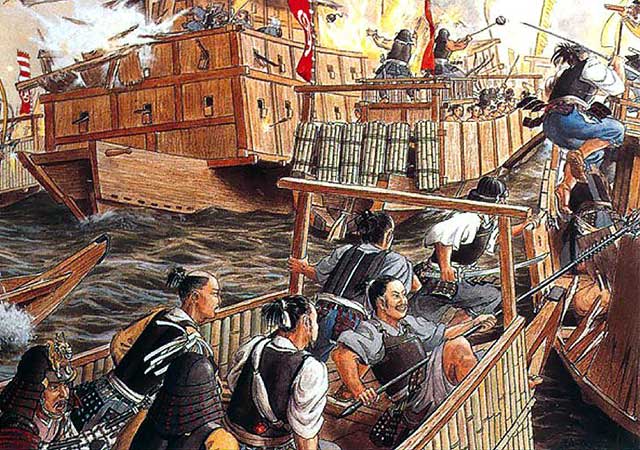
The pair of Kizugawaguchi Battles took place during Oda Nobunaga's endeavors to besiege the Ishiyama Hongan-ji in Osaka. Serving as the stronghold of the Ikko-ikki, a coalition of warrior monks, priests, and farmers in opposition to Oda's rule, the Hongan-ji posed a formidable challenge. To counter the Ikko-ikki's attempts to supply the fortress and break the siege, Oda commanded Admiral Kuki Yoshitaka to organize a blockade against their allies' fleets. Among the opposition were influential families, notably the Mori Terumoto from the Mori clan in neighboring provinces.
First Battle
In the initial clash in 1576, the Mori navy, led by Motoyoshi, the son of Murakami Takeyoshi, achieved victory over Kuki Yoshitaka's fleet. This defeat broke the blockade, allowing supplies to reach the fortress. Both sides employed firearms, a relatively new aspect of Japanese warfare. However, Mori's naval expertise and tactical knowledge proved decisive in this encounter.
Second Battle
Two years later, in 1578, with the Ishiyama Hongan-ji still under siege, Oda's fleet, under the command of Takigawa Kazumasu, coordinated a renewed effort. This time, Kuki Yoshitaka led six sizable o'atakebune ships against the Mori navy, deviating from the conventional use of a combination of small (kobaya), medium (sekibune), and large (adakebune) vessels. Typically, atakebune were floating wooden fortresses equipped with gun and bow emplacements. Some accounts suggest that these six vessels might have been Tekkosen, early ironclads designed to resist penetration by enemy weapons. However, it is likely that these crafts featured limited iron plating in specific areas rather than being entirely composed of metal.
During the battle, several Mori vessels under Murakami Takeyoshi were set ablaze and sank, ultimately resulting in victory for Oda's fleet. The supply lines were successfully severed, leading to the eventual fall of the Hongan-ji. However, a flaw in the Tekkosen design surfaced as Mori samurai rushed to board the large ship, causing it to capsize due to a shift in the center of gravity.
Following this triumph, Yoshitaka went on to defeat the Mori once again the following year.
See also
-
The Siege of Hara Castle

The Shimabara Rebellion of 1637–1638, which culminated in the siege of Hara Castle, was the last major uprising of the Edo period and had serious political consequences.
-
Battle of Tennoji

The confrontation between Tokugawa Ieyasu and Toyotomi Hideyori during the “Osaka Winter Campaign” ended with the signing of a peace treaty. On January 22, 1615, the day after the treaty was signed, Ieyasu pretended to disband his army. In reality, this meant that the Shimazu forces withdrew to the nearest port. On the same day, almost the entire Tokugawa army began filling in the outer moat.
-
Siege of Shuri Castle

The Ryukyu Kingdom was established in 1429 on Okinawa, the largest island of the Ryukyu (Nansei) archipelago, as a result of the military unification of three rival kingdoms. In the following years, the state's control spread to all the islands of the archipelago.
-
The Siege of Fushimi Castle

Fushimi can perhaps be considered one of the most “unfortunate” castles of the Sengoku Jidai period. The original castle was built by Toyotomi Hideyoshi in the southeast of Kyoto in 1594 as his residence in the imperial city.
-
The Siege of Otsu Castle

The siege of Otsu Castle was part of the Sekigahara campaign, during which the so-called Eastern Coalition, led by Tokugawa Ieyasu, fought against the Western Coalition, led by Ishida Mitsunari. Otsu Castle was built in 1586 by order of Toyotomi Hideyoshi near the capital Kyoto, on the site of the dismantled Sakamoto Castle. It belonged to the type of “water castles” — mizujō — as one side of it faced Japan's largest lake, Lake Biwa, and it was surrounded by a system of moats filled with lake water, which made the fortress resemble an island.
-
The Siege of Shiroishi Castle

The siege of Shiroishi Castle was part of the Sekigahara campaign and took place several months before the decisive battle of Sekigahara. The daimyo of Aizu Province, Uesugi Kagekatsu, posed a serious threat to Tokugawa Ieyasu's plans to defeat the Western Coalition, and Ieyasu decided to curb his actions with the help of his northern vassals. To this end, he ordered Date Masamune to invade the province of Aizu and capture Shiroishi Castle.
-
The Second Siege of Jinju Castle

During the two Korean campaigns of the 16th century, the Japanese repeatedly had to capture enemy fortresses and defend occupied or constructed fortifications from the combined Korean and Chinese forces. Among all the operations of that time, the second siege of Jinju Castle is considered the most interesting from the point of view of siege warfare.
-
The Siege of Takamatsu Castle

The siege of Takamatsu Castle in Bitchu Province is considered the first mizuzeme, or “water siege,” in Japanese history. Until then, such an original tactic had never been used.

